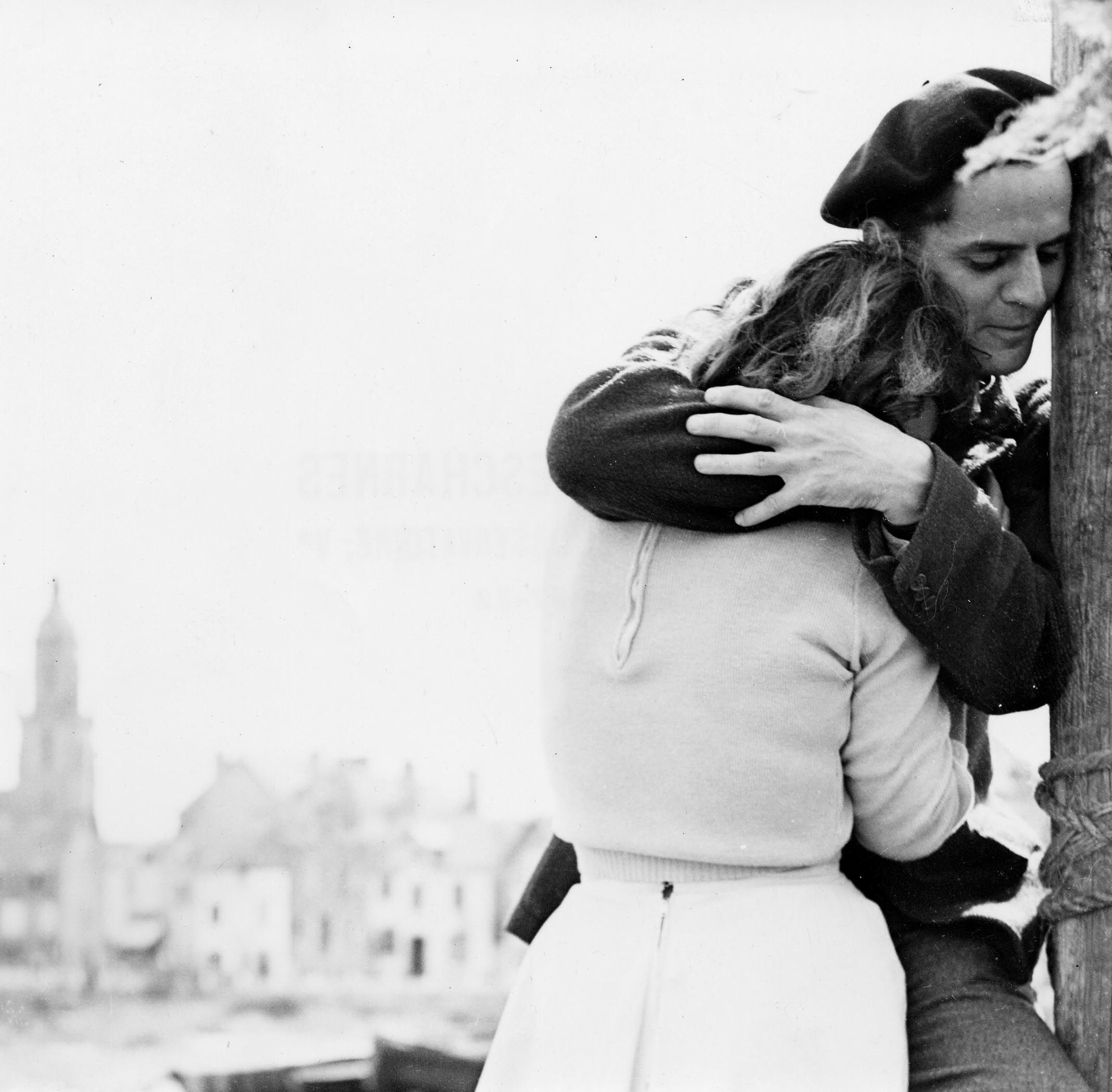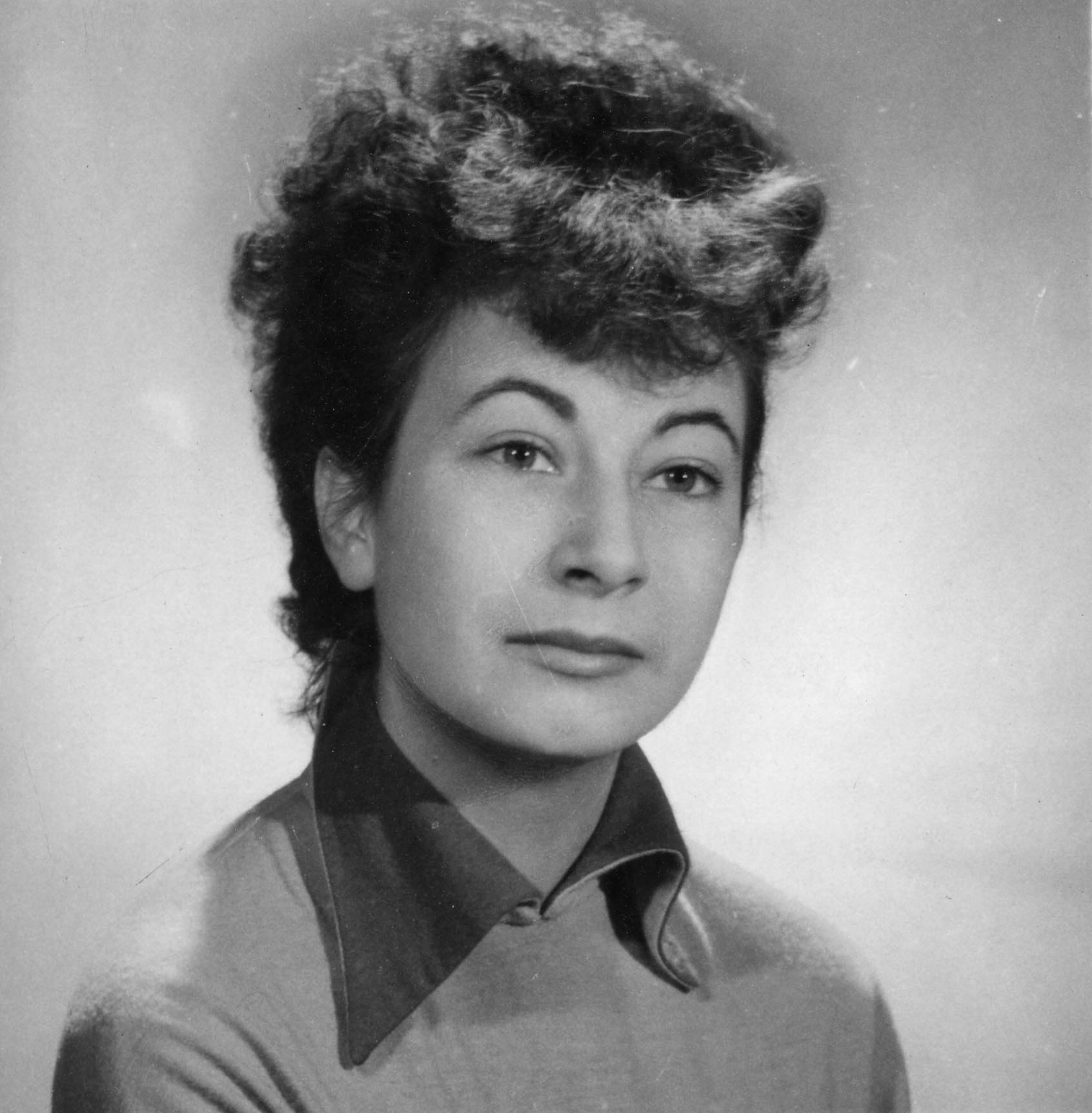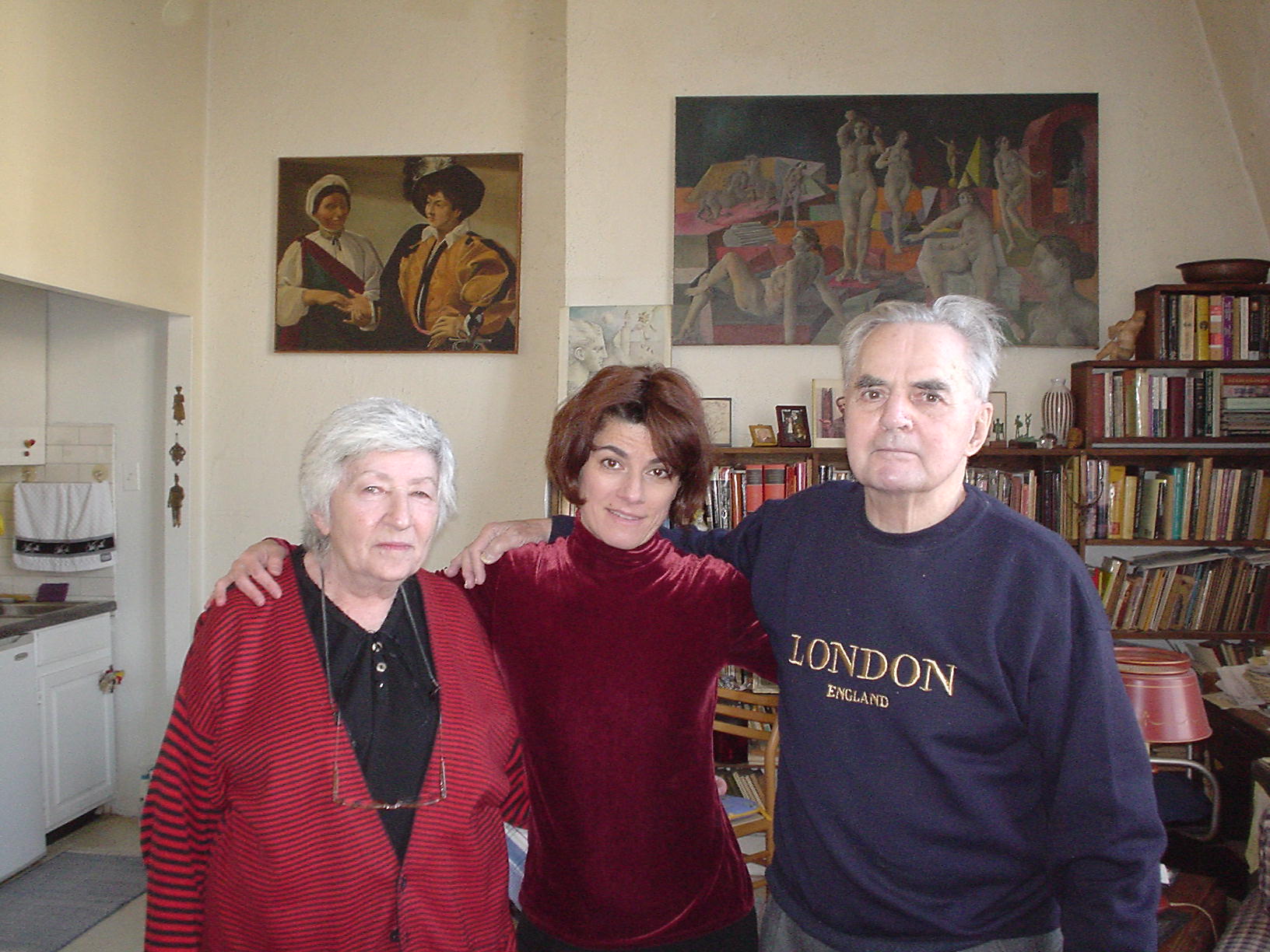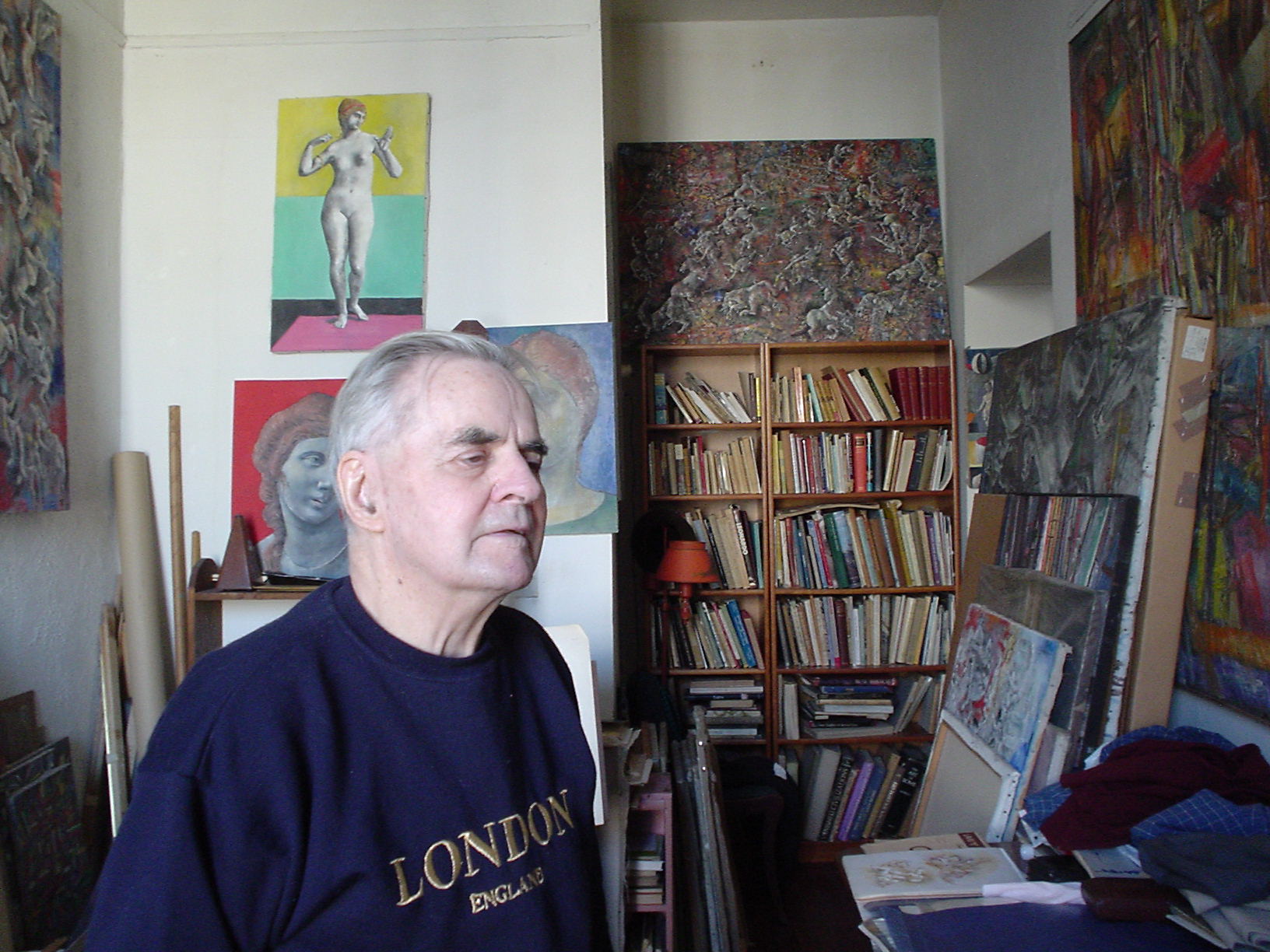
Alfred Russell and his Madness of Damnation
A Daughter's Story of a Family of Artists Destroyed by Anti-Semitism
By Elsie Russell
Alfred's War
On the eve of World War II Alfred Russell said goodbye to his old roommates from the University of Michigan. As Germans, they had enlisted and gone back to the fatherland. The days of singing Edelweiss at the Pretzel Bell were gone forever. Inspired by their drinking discussions, Russell had tried in vain to enlist in the German army, but was rejected. He then tried to enlist in the American army and was again rejected. “Come back after you eat some steaks,” he was told. Instead, he moved to New York, got a job with Newsweek in the art department and, unable to afford steaks, dined at the automat on 57th street for a nickel.
He was, however, not on this train from Penn Station because he was short of cash. He thought of his friends, who had introduced him to the music of Richard Wagner and Anton Bruckner, to the philosophy of Frederich Nietzsche and Arthur Schopenhauer, and to the poetry of Holderlin and Goethe. Americans were, in contrast to his friends, barbarians. New York was where all the Europeans went ― this was where civilization could be found in America. But New York was turning out to be the most barbaric town of all.
It had all began in Michigan while majoring in English Literature to become a playwright. A fellow student, a rich New Yorker named Arthur Miller, was getting all the attention for his plays full of socialist propaganda. Russell had to wait tables while this rich kid had it easy and got all the breaks! So Russell found a new calling, away from the pen to the brush, thanks to the mentoring of the Hungarian sculptor Frank Nagy.
Russell discovered Abstract Art and found fellow artists to share ideas and beer with at the Cedar Tavern. His star rose. He was handsome, charming to women, and fearless. He painted day and night, he learned etching and engraving from his new friend and mentor Stanley William Hayter, he became friends with Mark Rothko, Ad Reinhardt, Franz Kline and Willem De Kooning, and was mentioned in the same sentence with them, shown in the same galleries, written up in the same articles. His place in the Pantheon of Modern Art was secure. Russell, like everyone else still had to eat. Many artists had enrolled in the WPA. Russell began teaching at Brooklyn College. In 1949, the sky seemed the limit. He was famous. He went to France, perfecting his etching and engraving technique at Hayter's Paris Atelier 17. He met a witty and kind and very talented young artist, Andrée Déscharnes, and invited her to join him back in America where he lived and taught. The next year they were married , and expected a child. Luckily it was a sabbatical year, so they could return to France to have the baby, and Russell could continue his art in Paris.
Andrée's War
Armed with her Baccalaureate and a firm mastery of the German language Andrée Déscharnes sat on a train with her small suitcase, en route to her first job, teaching German schoolchildren the French language. Without warning at the German border the train screeched to a halt and turned back. Déscharnes returned to Nevers, joining the rest of her family in their full time dedication to the Résistance movement.
From this centrally located provincial capitol, Andrée's grandfather Pierre Auclair, a renowned botanist, social reformer and grand master Freemason (of the Grand Orient de France lodge), was busy coordinating communications for the movement and his country. As the war progressed his responsibilities increased from keeping the local population fed through a secret web of trade for food and services, to hosting and funneling Jewish families from France, Northern and Eastern Europe across the ocean to the Americas via a pipeline of friends and family.
Pierre Auclair's daughters and granddaughters worked with him in various capacities, from nursing to social services. His only son Pierre was already in a German prison camp. Andrée became an FEE scout leader, teaching French schoolchildren to evade Germans, as one of her Résistance tasks was to go out in the countryside with her troop of little louvettes or brownies and older éclaireuses or girl scouts, and smuggle information, town goods and cash in exchange for information, farm fresh eggs, cheese, and vegetables. The farmers, although under orders to hand over their production to the occupation forces, always kept enough hidden for this pint sized army.
Back at “Les Pèrrieres,” as the Auclair house on the edge of town was called, the family set up cozy hidden apartments - in the basement behind the wine cellar and in an ancient hayloft - in preparation for the steady flow of Jewish refugees. The property's 14 hectares was adapted to grow a variety of crops as well as raising chickens and escargots. There were already plenty of fruit trees and a working vineyard, so they made jams, pickles and wine. They grew weird vegetables the Germans wouldn't confiscate in the garden and made bread from acorn flour. The house, built on the site of an old limestone quarry, happened to be one of the nicest in town, with its own tennis court, tiny forest and formal rose bush alleys, so it was an easy decision for the Germans to commandeer the property for their high ranking officers. As soon as they could, Andrée and her mother Marie gathered all of Pierre Auclair's records and letters for the Résistance and burned them in the middle of the tennis court with some fallen leaves, safeguarding the identities and activities of Résistance members. The soldiers moved in, claiming the choicest rooms, the best selections from the wine cellar, even playing tennis against Andrée and her little brother Robert ― all the while keeping an eye on the wily Freemason.
Each evening, an extended family of “cousins” would appear at the dinner table. After the meal they would regroup in the salon for a concert, playing the violin or clarinet with Andrée on the piano. This life of subterfuge could not last, however, and the Germans took hostage and arrested 14 year old Robert on the false charge of firearm possession after discovering a non-functioning antique pistol given Robert by his drawing teacher as a still life prop. Even after Robert was shipped off to a camp without a trial, Pierre Auclair continued his Résistance activities. Then, on the 16th of July, 1944, Nevers was strategically bombed by the Americans, destroying the railroad station and dealing the Germans a cruel blow.
The next time the “coal delivery truck” drove up from the mines in the Cèvennes mountains run by the husband of Pierre's eldest daughter, Renée, both basement house guests and their hosts climbed in, were covered with blankets under a layer of coal, and were smuggled out of Nevers to southwestern France.
After the Liberation Andrée Déscharnes, finally free to pursue her dream of becoming an artist, enrolled in the Ecole Nationale des Beaux Arts in Paris. Tragically, the academy was nearly emptied of professors, and just a few determined students still attended the unheated classrooms. Between classes Déscharnes supported herself designing war cemeteries for the American Army. After graduation from the Beaux Arts she began her career as textile designer with the premier French textile house, Nobilis. Déscharnes remained in Paris working for the firm until 1949 when she met the devilishly handsome young American painter Alfred Russell, then a rising international art star. By the end of that year, she was on her first transatlantic flight to rejoin him in New York, where they married at City Hall with painter Ad Reinhardt as best man.
Married Life
By 1950, the newlyweds were back in Paris, with Alfred on sabbatical leave from his teaching career at Brooklyn College and shortly thereafter Andrée had her first child, a son, Guillaume, in Nevers. The baby, however, died after one month, of crib death, and the parents returned to New York heartbroken. Alfred sought refuge in the arms of one of his freshman students, Joan Silverman, while Andrée worked as a textile designer and window dresser to maintain independence and to appease Alfred's increasingly volatile temperament. He blamed her for not furnishing him with the luxurious lifestyle a rich wife would have and thus being a parasite and drain on his creative genius, even though she was bringing in as much money as he was as teaching adjunct. It was during this time that one of Alfred Russell's most troubling obsessions came to light for her: his staunch, culturally nurtured anti-semitism, which he had kept hidden during the postwar euphoria and his rise to stardom.
Self-Destruction
Alfred Russell's focused his talent for self destruction further away from home and upon those very persons most in a position to further his career. One story goes that Peggy Guggenheim,who owned the gallery Art of This Century, approached Russell at a party and made sexual advances to him, stroking his eyelashes and inviting him to be her “protegé.” He spat in her face on the spot, to which she countered something to the effect of “You'll never show in this town again,” and went home that evening with Jackson Pollock on her arm. Even before Alfred Russell decided to abandon abstraction in painting and focus on the human form, the critic Clement Greenberg decided Russell's intellectual approach to Abstraction was not in tune with the times. Russell countered this attack with a barrage of anti-semitic slurs. Overnight, many of Russell's friends and supporters turned their backs on him. The reasons he gave publicly were aimed against the increased commercialization of this breakthrough approach to art, with an influx of dealers looking for fashionable inventory and artists wanting to jump on the band wagon for a quick ride to fame and fortune.
One of Russell's memorable and thoroughly self destructive insults at this time was to approach Clement Greenberg, whom he suspected had a pro-Zionist agenda in his choice of art and artists and in furious irony, exclaim, “Are you wearing your Star of Judas for this one?” (not even a “Star of David!”) But this flip tone became habitual. He addressed another top art critic, John Russell, with “So, and how long has your name been Russell?” suggesting that Mr Russell had come to this world with a hard to pronounce surname of non Anglo-Saxon origin.
Thoroughly disgusted with all aspects of the contemporary art world, Russell began studying anatomy at the Arts Student's League under Robert Beverly Hale, and enrolled at Columbia University to pursue his doctoral degree in Art History, specifically in Hellenistic sculpture under the tutelage of renowned German born historian Margarete Bieber. Russell had always been attracted to the civilization of Ancient Greece ― its art, drama, and philosophy. Above all, it was the tormented hyper-emotional language of Hellenistic sculpture that proved the perfect vehicle to channel Russell's tragic nihilism, fueled by the Existential German philosophy he had begun to study with his Teutonic roommates at the University of Michigan. But his attraction to Fascism went deeper than the usual ideas of of racial purity and cultural identity. They were easily embraced in light of Russell's blue blood heritage and a family that had just disowned his aunt for marrying a Jew. Abandoned at seven by his flapper mother, (who ran off with Lucky Luciano, only to die alone in an Atlantic City flophouse) to be raised by his father's cold, status obsessed family.
After the World War it was the evolution of the cold war than would stoke Russell's anti-semitic bias through his continued perception of Socialism as a method of Zionist infiltration, particularly among the WPA's Jewish artists and intellectuals. As a member of the Cedar Tavern “Club,” he had plenty of debating partners, and friends to turn into enemies. Some would refuse. Alfred Russell's relationship with the intelligentsia of both continents had become very complicated, and although many openly snubbed him, other friends were willing to overlook his indiscretions. In 1949 he had made friends with the surrealist mystic and champion of West Coast Native American art and myth, Kurt Seligmann and his wife, Arlette. They were to remain his loyal mentors and friends throughout their lives, lending their Paris mansion on the rue de la Tombe Issoire to Alfred and Andrée during his 1956 sabbatical and becoming god parents to his daughter later that year. Seligmann was a shaman like mystic and had analyzed Alfred's demon infested dreams and behavior, and emphasized that he needed understanding, not banishment. Also during this period, the great art historian, Meyer Shapiro championed Russell, his student at Columbia, and remained a close friend of the family until his death in 1996, albeit apologetically.
The Mistress and Madness
From the 1950's on, Alfred Russell's path of self destruction continued its ever widening swath but was most felt at home. Joan Silverman would remain Alfred Russell's primary mistress, even after my birth in 1956, during the next sabbatical after the birth and death of little Guy. He was, in fact, with Joan in Paris as I was born in Nevers, and the story goes that Joan, when informed that I had entered the world, fainted in the middle of the “Pont des Arts,” the pedestrian bridge that crosses the Seine. She would have to wait until shortly before Andrée's premature death to reunite with her lover, because they were together in Rome when I called to inform Alfred of the death. The two of them promptly and without apology abandoned any responsibility for my welfare even though I had put my late teens on hold to nurse my mother and maintain the household in those last excruciating years of her life. Alfred and Joan fled to the Riviera with the family savings, as well as Andrée's life insurance and the house sale money, leaving no address as to their whereabouts for two years, when they resurfaced living comfortably in the Chelsea Hotel.
It was no secret that Alfred Russell's increasingly irrational and volatile behavior after the mid nineteen sixties was largely physiological in origin. He had mysteriously developed a form of epilepsy, with regular petit mal seizures and absences, but refused to seek medical help until several years later. Imaging technology had not been invented, and doctors relied on the EEG, or electroencephalograph, to diagnose Alfred's brain malfunctions. Alfred first saw a neurosurgeon in Rome in 1972 who told Andrée that he believed Alfred had a brain tumor, but for some reason declined to inform Alfred of this tentative diagnosis. By 1973 Russell had to take sick leave, extending a Rome vacation. More than anything he dreaded the return to teaching at Brooklyn College. Many of the faculty had actively formed against him, effectively vetoing a pay increase to full professorship, and petitioning for his resignation. Russell was sought after around the globe for his teaching skills and brilliant coaching, but the art faculty of the college had had enough of his anti-semitic and anti-racial slurs. And now he was in no condition to defend himself against the enemies he had amassed.
Anti-Semitism Comes to Suburban NY
With Alfred's illness, the house in Croton-on-Hudson (a bedroom community fifty miles from New York City), was sold and all possessions were put in storage. Alfred Russell's behavior at home had become so horrific that before returning to New York in fall of 1973, I was left behind as a boarding student at St. Stephen's school, the American curriculum prep school I was attending. The expensive tuition was almost entirely paid for by Andrée's meager savings. Andrée wanted to keep me safe from the crime pit the New York had become in the late seventies with its dangerous and mediocre public schools, and a US private school would have been too expensive if I could even get in on such short notice. But more importantly she made the decision to avoid any more of Alfred's destructive behavior and its repercussions on my mental development. Already at the Croton school, Alfred's anti-semitic antics had reached theatrically absurd heights. For instance: a neighbor who was also a high school English teacher, was having a party to celebrate his son's bar mitzvah. As the festivities became more joyful and the music crescendo-ed, Alfred became so infuriated that he climbed to the roof of our house with two enormous speakers and drowned out their music with German Nazi marching songs. Andrée sat downstairs at her desk and cried. We knew he was ill. But what could we say or do? The next year, when I had this teacher for English, he consistently failed me even though English was one of my strongest subjects.
School in Rome away from Alfred was for me a great blessing and opportunity. I had friends and good grades free of prejudice. Although I had little pocket money, I began to seriously study drawing and painting, frequenting all the great museums in my free time. Far from my father's relentless misogynist rants and constant belittling, I was free to grow and become a complete person. However, in the middle of the school year, Andrée was diagnosed with uterine cancer. In the turmoil, my college applications were left unsigned among the pile of bills waiting for Andrée's attention. Finally Alfred and a thin but undaunted Andrée arrived in time for my graduation.
Death and Disaster
I had come home to find I had two very ill adults to care for and deal with. Andrée did what she could to salvage the family from her bedside. The last of Andrée's life savings went towards my tuition at Pratt Institute, where I went to classes in between my responsibilities as caregiver and secretly earning money to feed Alfred the cuisine he demanded but would not provide for. Alfred's outbursts were daily both in private and in public and nearly got him arrested several times. One day, when I accompanied him to the Guggenheim museum, he was picked up and thrown out the door by two security guards after threatening the desk clerk. I apologized for him and they let us go home. Eventually, even my spotty university studies were halted by Andrée's illness, and we left for France, traveling with an oxygen tank and one suitcase in an ambulance. After Andrée's death at the family home in Nevers and the subsequent abandonment by Alfred and Joan Silverman, I returned to the States to apply for student aid services to continue my studies ― only to discover that Alfred was deducting me from his taxes as a dependent, even though I had no knowledge of his whereabouts and was not receiving support of any kind.
By the late seventies, though, Alfred Russell's career began to rise from the morass he had shoved it into as he and his new bride were becoming more socially active and the new Mrs. Russell took it upon herself to resuscitate his career. She was a respected classical scholar at New York University, and had been in the New York Academic system her entire life. Did Joan's effort, both as an accomplished educator at New York University, as well as being Jewish herself, help? Alfred had joked cruelly with Andrée that it would have been more auspicious than the road taken. Andrée, who had remained a French citizen, was never involved in academia and even her own accomplished painting career was stymied by her association with Alfred, and her repeated efforts in that area were fruitless. But, most likely, it was the times. The renewed interest in figurative art in the late sixties opened the gates and was well established by the mid seventies. Russell began to attract interest from a few nascent figurative dealers, curators and critics, such as Peter Tatistcheff, David Lawall of the University of Virginia's Bailey Museum and Sidney Tillim of Art Forum. Former students such as Jed Perl, and Gabriel Laderman among had also ascended to respected positions. These voices helped put Russell's career in proper perspective through their writing and outspoken support of his talent and influence. Not to be dismissed are the legions of painters, students and their students who were no longer afraid to claim Russell as an inspiration. Because of this concerted effort, Alfred Russell was able to exhibit and sell paintings regularly until his death in 2007.
Postlude
However, his place in history would have been more secure had he not so obstinately held on to his prejudices, particularly his anti-semitism. Joan recounted to me and my husband, Jeff Harrington in 1982 a conversation she had with Leo Castelli, an early mentor of Russell's, in which Castelli had confided that, although he greatly admired Alfred's work, he could never give him a show ― precisely because of his anti-semitic comments through the years, and that Joan “shouldn't even get her hopes up.”
Now that both Alfred Russell and Joan Silverman Russell have died, the process of whitewashing Alfred Russell's reputation has begun. The reason is, of course, money, and the few works that have escaped Russell's negligence, outright destruction, theft or loss are finally fair game for academics and art marketeers alike.
The question is not whether Alfred Russell was a great artist or not. It is not whether his breakthrough abstractions are worth more than his figurative works, whether his engravings, etchings, or drawings are more interesting than his paintings, or even his few sculptures. It is not whether Alfred Russell was an anti-semite ― he was. A misogynist, philandering spouse and abusive parent ― he was all those. Sane or insane ― that is endlessly debatable. A great and loyal teacher ― there is no question that he was. However, the artist as a complete entity needs to be understood and appreciated, without their story being skewed to appeal to market or academic interests. This article is merely an introduction for Alfred Russell's life, a life rich with experiences that counterbalanced his shortcomings and that informed his imagination, transforming him into the larger than life person he was. And yet, much will be lost if the knowledge held by his remaining kin and friends on both sides of the Atlantic are overlooked by greedy biographers and curators. These issues need to be investigated and addressed before a shrink wrapped version of the goods is served up to the world.

Alfred and Andrée in Paris in the late 1940's.

Russell in the 1960's.

Andrée Descharnes

Alfred being entertaining at dinner in the 1950's.

Elsie, Alfred and Joan at the Chelsea Hotel Apartment, 2003.

Alfred in his studio in 2003 at the Chelsea Hotel.